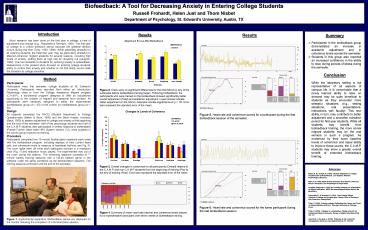Results - PowerPoint PPT Presentation
1 / 1
Title:
Results
Description:
Biofeedback: A Tool for Decreasing Anxiety in Entering College Students Russell Frohardt, Helen Just and Thom Nisbet Department of Psychology, St. Edward s ... – PowerPoint PPT presentation
Number of Views:4
Avg rating:3.0/5.0
Title: Results
1
Biofeedback A Tool for Decreasing Anxiety in
Entering College Students Russell Frohardt, Helen
Just and Thom Nisbet Department of Psychology,
St. Edwards University, Austin, TX
Introduction Much research has been done on
the first year in college, a time of adjustment
and change (e.g., Pascarella Terenzini, 1991).
The first year of college is a critical
transition period because the greatest attrition
occurs during this time (Tinto, 1993 1998).
While potentially stressful for all entering
students, the freshman year may be particularly
stressful for Mexican-American migrant students
for several reasons, including high levels of
anxiety, putting them at high risk for dropping
out (Laughlin, 1980). One tool available to
students for reducing anxiety is biofeedback.
Researchers in the present study focused on
entering college students ability to control
their anxiety and whether or not that ability
would make the transition to college smoother.
Results Figure 2. There were no
significant differences for the total SACQ or any
of the subscales before biofeedback training
began. Following biofeedback, the participants
who were trained on the biofeedback showed
significantly better overall adjustment (Total)
and academic adjustment. Lower scores indicate
better adjustment on the SACQ. Asterisks indicate
significance at p lt .05. Error bars represent the
standard error of the mean. Fi
gure 3. Overall changes in coherence for all
participants (Overall) relative to the C.A.M.P.
and non-C.A.M.P. students from the beginning of
training (Pre) to the end of training (Post).
Error bars represent the standard error of the
mean. Figure 4. Summary of mean heart
rate (above) and coherence levels (below) for a
representative participant over seven weeks of
biofeedback training.
Results Figure 5. Heart rate and
coherence scores for a participant during the
first biofeedback session of the
semester. Figure 6. Heart rate
and coherence scores for the same participant
during the last biofeedback session.
- Summary
- Participants in the biofeedback group
demonstrated an increase in academic adjustment
and in coherence levels across the semester. - Students in this group also reported an increased
confidence in the ability to relax during periods
of stress during the semester. - Conclusion
- While the laboratory setting is not
representative of all aspects of campus life, it
is conceivable that a newly learned ability to
relax on demand may be quite beneficial to
students as they encounter more stressful
situations (e.g., testing situations, oral
presentations, interactions with faculty). This
new ability, in turn, may contribute to better
adjustment and a smoother transition period for
first-year students. While all students may
benefit from biofeedback training, the more
at-risk migrant students may be the real winners
in such a program. As evidenced by their lower
baseline levels of coherence and equal ability to
improve those scores, the C.A.M.P. students may
show a greater overall benefit of extended
biofeedback training.
Method Participants Participants were first
semester college students at St. Edwards
University. Participants were recruited from
either an Introductory Psychology class or from
the College Assistance Migrant program
(C.A.M.P.), a scholarship program designed to
offer an educational opportunity to the children
of migrant and seasonal farm workers. All
participants were randomly assigned to either the
experimental (biofeedback) group (N 25) or the
control (no biofeedback) group (N
30). Design All subjects completed the SACQ
(Student Adjustment to College Questionnaire
(Baker Siryk, 1989) and the Beck Anxiety
Inventory (Beck, 1990) to assess adjustment to
college and anxiety at the beginning and the end
of the semester. Half of the psychology students
and half of the C.A.M.P. students then
participated in weekly sessions of biofeedback
(Freeze Framer Heart-math HRV System Version
2.0), while subjects in the control group
received no training. Procedure Participants
completed two 15-minute familiarization sessions
each week with the biofeedback program, including
displays of their current heart rate, and
coherence levels (a measure of heartbeat rhythms
see Fig. 5). The room lights were off while each
participant reclined in a relaxation chair (Fig.
1) and relaxation music played. The experimenter
was out of the room during the session. The
remaining sessions consisted of 7-minute weekly
training sessions with a hot-air balloon game in
the software under the same conditions as the
familiarization sessions. The training sessions
continued until the end of the semester.
Figure 1. Experimental apparatus.
Biofeedback panels are displayed on the monitor
following the completion of a familiarization
session.
References Baker, R. W., Siryk, B. (1989).
Student Adaptation to College Questionnaire
(SACQ) Manual. Los Angeles Western
Psychological Services. Beck, A.T. (1990). Beck
Anxiety Inventory. San Antonio Harcourt Brace
Company The Psychological Corporation. Laughlin,
Margaret A. (1980). An invisible minority An
examination of migrant education. (ERIC Document
Reproduction Service No. ED191611). Pascarella,
E., Terenzini, P. (1991). How College Affects
Students Findings and Insights from Twenty Years
of Research. San Francisco Jossey-Bass.
Tinto, V. (1993). Leaving college Rethinking
the Causes and Cures of Student Attrition (2nd
ed.). Chicago University of Chicago
Press. Tinto, V. (1998). Colleges as
communities Taking research on student
persistence seriously. Review of Higher
Education,21(2), 167-177. Useem, M., Karabel,
J. (1986). Pathways to top corporate management.
American Sociological Review, 51, 184-200.































